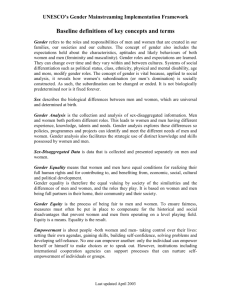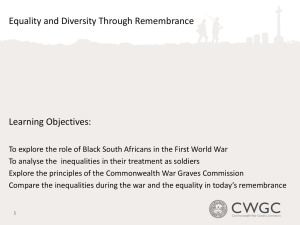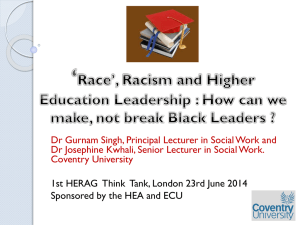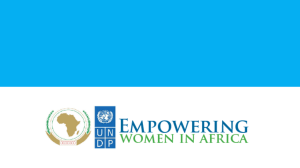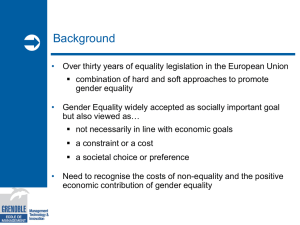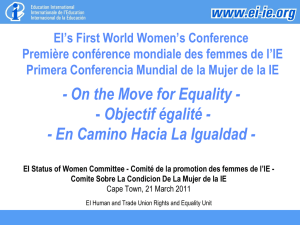GENDER ISSUES ACADEMIC YEAR 2013-2014
advertisement
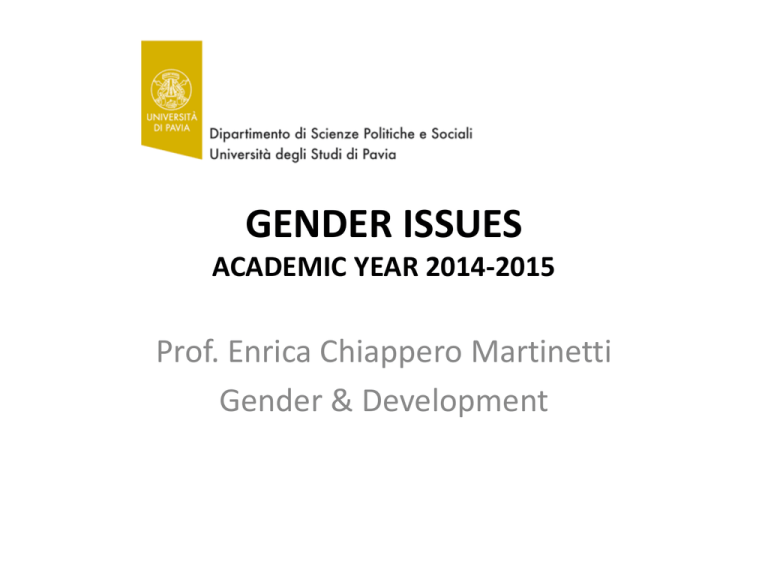
GENDER ISSUES ACADEMIC YEAR 2014-2015 Prof. Enrica Chiappero Martinetti Gender & Development Course’s aims and contents Aims • to discuss the linkage between gender equality and development issues in a globalized world Contents • Gender inequalities and gender progress around the world • Measuring gender inequalities • The impact of globalization and development on gender (in)equality Lectures’ contents Lecture #2, October 2ndt, Thursday 11-13 Course presentation: the roots of the gender debate in development economics (E.Chiappero-Martinetti) Readings: – Razavi, C. Miller, From WID to GAD: conceptual shifts in the women and development discourse, UNRISD, February 1995 (downloadable at the UNRISD website) – C. Okali, Searching for new pathways towards achieving gender equity. Beyond Boserup and ‘Women’s role in economic development’”, ESA Working paper no. 11-09, 2011 (downloadable at the FAO website) Lectures’ contents (2) Lecture #4, October 9th, Thursday 11-13 Gender inequalities and gender progress around the world: an overview (E.Chiappero-Martinetti) Readings: – World Bank, Gender Equality and Development, World Development Report 2012, selected sections of Part I (full report downloadable at the World Bank website) Lecture #8, October 23th, Thursday 11-13 Measuring gender inequalities: the UNDP new gender inequality index: Gender Inequality Index and Gender Development Index (E.Chiappero-Martinetti) Readings: – UNDP, Human Development Report 2014 – pp. 39-40; 74-75; statistical tables pp. 172-179; technical notes pp. 5-8. Lectures’ contents (3) Lecture #10,October 30th, Thursday 11-13 Measuring gender inequalities: the global gender gap report of the WEF (E. Chiappero-Martinetti) Readings: - World Economic Forum, The Global gender gap report 2013, selected sections of Part 1-Measuring the global gap and country profiles (full report downloadable at the World Economic Forum website) Lecture #14, November 13th Thursday, 11-13 Measuring gender inequality in Italy (E. Chiappero-Martinetti) Readings: – Amici M., Stefani M.L. (2013), A gender equality index for the Italian regions, Banca d’Italia, Occasional Paper n. 190, June. Lectures’ contents (4) Lecture #16, November 20th Thursday 11-13 The impact of globalization and development on gender equality (E.Chiappero-Martinetti) Readings: – World Bank, Gender Equality and Development, World Development Report 2012, selected sections of Part III (full report downloadable on the World Bank website) Lecture #18, November 27th ,Thursday 11-13, Women empowerment and economic development (E. ChiapperoMartinetti) Reading: – Duflo E. (2012), Women empowerment and economic development, Journal of Economic Literature, 50,4, pp. 1051-1079 Further info Course readings • Further readings might be provided during the course in addition Students’ assessment • a 9-10 pages paper on a subject agreed with one of the teachers Gender and development Several crucial steps for the international debate • (CEDAW, Convention for the Elimination of All Forms of Discrimination Against Women, 1979): women rights to receive training, education, services and credits • World Conference on Human Rights, Wien, 1993 • UN decade for women (1976-1985) – Mexico City (1975), Copenhagen (1980), Nairobi (1985) UN conferences • Bejing Conference (1995) WID, WAD, GAD • Changing paradigms, thinking and practice on women, gender and development – From ‘WID’ – women in development (early ’70s)and ‘WAD’ – women and development – to ‘GAD’ – gender and development (mid ‘90s) • Some continuities in thinking on women/gender & development as well as several remarkable differences in concepts and policies • early 70s women as ‘passive’recipients of support and assistance (and mainly as mothers and wives); from 1975 onwards strategies to give women equal access to edu and empl opportunities, political representation and participation; social welfare ‘WID’ • ‘Women in Development’ (E.Boserup’s book “Women’s role in economic development”, 1970 ) – Rooted in modernisation theory and liberal feminist ideas on equality • • • • Modernization has a different impact on M and W Devl process appeared to deteriorate woman’s rights, position and status Women subordination linked to their exclusion from the market-place Resurgence of women’s movement in northern countries • • • • • Economic change = empowerment Equal rights, employment, equity and citizenship Improve education and employment opportunities Equality in political and social participation Increase in health and welfare services – WID agenda: – Emphasis on women’s productive role: • Investing in human capital • micro-credit policies Nb: gender efficiency approach (even if combined by egualitarian arguments) ‘WAD’ • ‘Women and Development’ – Rooted in dependency theory and Marxist feminist ideas – Economic change = empowerment – Advocated no real policy change around involving women in the development process ‘GAD’ – Rooted in post-development theory and post-structuralist critiques in feminism – UN Bejing Conference, 1995 – Economic change ≠ empowerment – Gender ≠ women – Refocus on ‘gender relations and roles’ above ‘women’ as a category – Effective poverty reduction is gender aware Gender • Gender recognises that women and men have different needs and interests which need to be addressed differently – knowing what they are is fundamental to deliberately ensure that our interventions have a tangible impact in promoting equality between men and women; – addressing the constraints and barriers that prevent women from fully exercising their rights, developing their potential and to exercise duties is fundamental to achieve gender equality ; • Therefore, gender equality is about enabling women and men to choose => Human Development Approach 13 Human development defined as: being “ … about creating an environment in which people can develop their full potential and lead productive, creative lives in accord with their needs and interests.” “ Development is thus about expanding the choices people have to lead lives that they value.” “ Fundamental to enlarging these choices is building human capabilities —the range of things that people can do or be in life. The most basic capabilities for human development are to lead long and healthy lives, to be knowledgeable, to have access to the resources needed for a decent standard of living and to be able to participate in the life of the community. Without these, many choices are simply not available, and many opportunities in life remain inaccessible.” HDR 2005 14 To sum up ° Origins ° Focus ° Problem ° Aims ° Solution ° Strategies WID - 1975/1985 U.N.decade - women GAD - Bejin Conference, 1995 - Relationships between men and women - Women exclusion from development process - more efficient development process - Need to integrate women in development processes - Promote development projects for women - Increase women productivity and income - Unequal power relationships that prevent equal and participative development - Fair and sustainable development with men and women as decision-makers - Change unequal relationships and give power to women - Support men and women to improve their living condition - Address women’s strategic interests - Promote people-centered development processes
